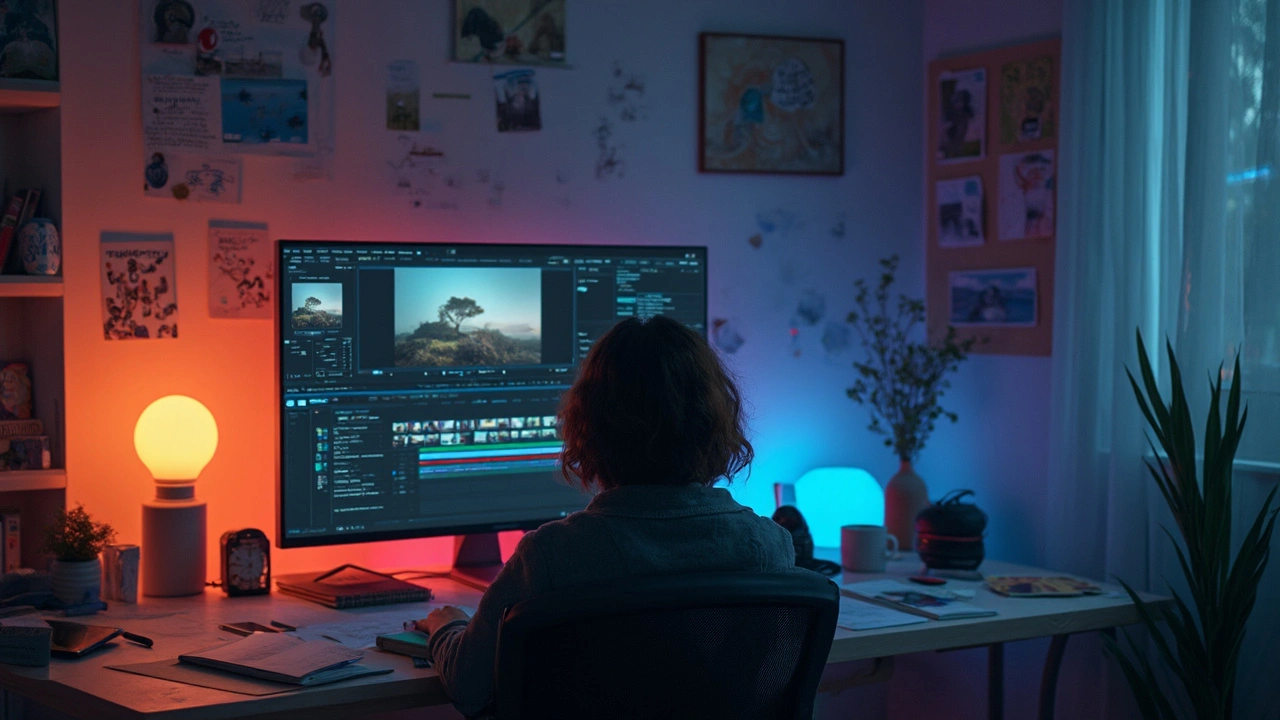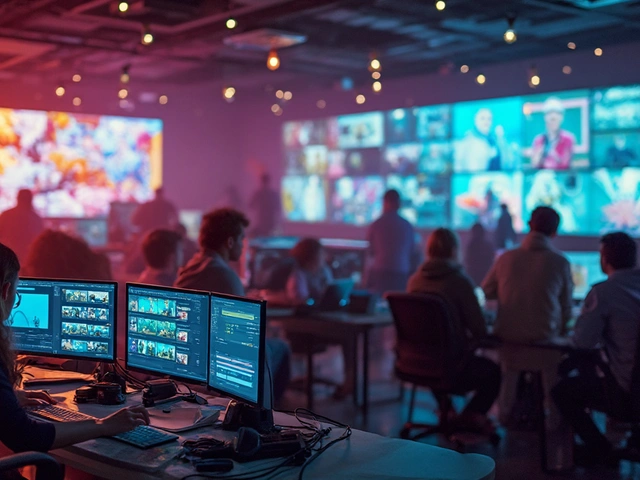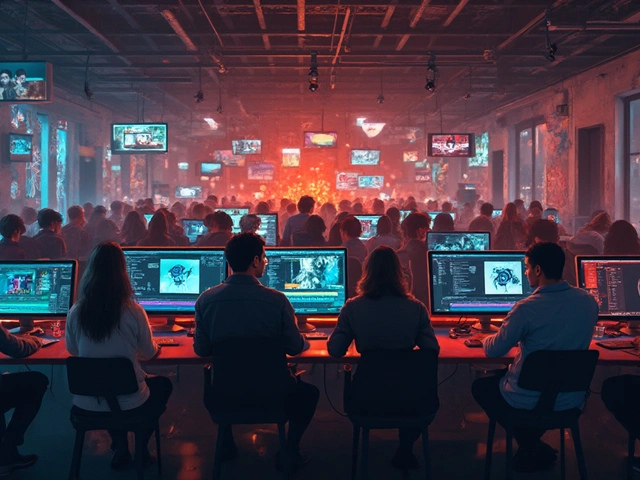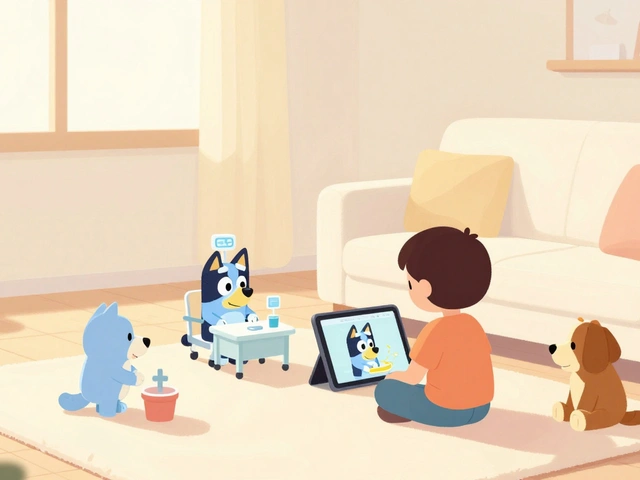5
Video Editing Software: Your Go-To Guide for Smooth Edits

Video editing software has come a long way, hasn't it? Remember when editing was a job for the pros with crazy expensive gear? Now, with just a computer and the right software, almost anyone can make a video look awesome. Whether you're a newbie trying to make your first YouTube video or a seasoned pro working on a film, video editing software is your best friend. Let's talk about what really makes these programs tick.
First up, you've got to know the tools of the trade. Basic video editing software will let you cut and stitch clips together, maybe add a bit of music, right? Those are beginner essentials. But if you're shooting for the stars, you'll want more advanced features. Think color correction, sound editing, multi-camera editing. The goal is to find the tool that matches what you're trying to do. No sense in overpaying for stuff you'll never use!
- Introduction to Video Editing Software
- Features that Matter
- Choosing the Right Tool
- Tips for Efficient Editing
- Future Trends in Video Editing
Introduction to Video Editing Software
So, you've decided to dive into the world of video editing? Awesome choice! Even if you’re just starting, understanding video editing is key to making your content pop. There’s a bit of magic in transforming raw footage into something special, and that magic happens on your computer screen.
Video editing is all about taking those clips you shot and turning them into a smooth, entertaining story. Thanks to modern video editing software, this process is a lot easier today. We've moved from the age where that kind of magic required specialized equipment to now, where all you need is a decent laptop or desktop and some solid editing software.
The Evolution of Editing Tools
Back in the day, video editing was a labor-intensive process involving every tool imaginable from scissors to tape. Now, with software, everything you need is digital. Programs like Adobe Premiere Pro and Final Cut Pro lead the pack in pro circles, offering features galore. Meanwhile, if you’re just beginning, tools like iMovie or Windows Movie Maker might be more your speed.Key Software Features
When you open up a video editing program, what do you see? Timelines, tool palettes, preview screens – that's the control center for your creativity. Basic features you’ll definitely want include trimming and splicing footage, adding audio tracks, and maybe some funky transitions or effects. But as you advance, you might look for tools that offer color grading, green screen effects, or even 360-degree video editing.Unlike the old days, today’s software also helps you manage your workflow. You can categorize your clips, color-code your timelines, and set markers for important moments. All these features help you work not just faster but smarter.
Video production experts estimate that almost 50% of video editors nowadays use cloud-based solutions for ease of access and collaboration. Check out this simple comparison of features between popular tools:
| Feature | Adobe Premiere Pro | Final Cut Pro | iMovie |
|---|---|---|---|
| Color Grading | Advanced | Advanced | Basic |
| Audio Editing | Professional | Professional | Basic |
| Multi-Camera Editing | Yes | Yes | No |
So, now you know the basics of what makes video editing software tick. Whether you're looking to bring home movies to life or create your next cinematic masterpiece, finding the right tool is the first step to greatness.
Features that Matter
When it comes to choosing video editing software, the features you need can make all the difference in your editing journey. You want to make sure you’re getting the best bang for your buck, right? So, let's break down what features really stand out and why they matter.
Basic Editing Features
Every video editing software worth its salt will let you cut, trim, and splice clips. But beyond that, you should look for tools that enable easy timeline editing and audio adjustments. A well-designed timeline interface can save you loads of time, making it intuitive to see your entire video structure.
Advanced Editing Tools
For those diving deeper, advanced features are a must. Look for motion tracking, which lets you attach elements to moving objects, and chroma key (or green screen) for those film-like special effects. If you plan to work on detailed projects, features like multi-cam editing and 360-degree video support might be crucial.
Audio Editing Capabilities
Great videos don't just look good; they sound good too. Ensure your software allows fine control over audio levels, background noise reduction, and maybe even some built-in sound effects. A handy feature can be automatic audio syncing, which aligns external audio to the video clips effortlessly.
User-Friendliness
You don’t want to waste hours trying to figure out your software. The interface should be intuitive, letting you dive straight into creativity without getting bogged down by complex tools. Look for user reviews talking about ease-of-use—that’s usually a good indicator.
| Feature | Importance Level |
|---|---|
| Timeline Editing | High |
| Motion Tracking | Medium |
| Audio Level Control | High |
| Chroma Key | Low to Medium |
In summary, the choice of video editing software should hinge not just on the fancy features they offer but how well those features align with your project needs. Consider starting with a trial version if possible, so you can test-drive the software before committing.

Choosing the Right Tool
So, you're on the hunt for the perfect video editing software. But with so many options out there, how do you choose the right one? It all comes down to matching the tools to your needs. Let's break it down!
Consider Your Skill Level
If you're just starting out, you probably don't need the full suite of advanced features. Look for something user-friendly like Wondershare Filmora or iMovie. They're great for beginners and won't overwhelm you with tons of buttons and options.
Think About the Features You Need
Got specific needs like 4K support or multi-camera editing? Then go for something more advanced like Adobe Premiere Pro or Final Cut Pro. They offer features that can handle anything you throw at them, whether it's a simple project or a complex film edit.
Don't Overlook Your Computer's Power
Before you dive into downloading applications, check your computer's horsepower. Some of these programs are resource hogs. Make sure your machine can run them smoothly without any hiccups.
Compatibility Matters
Always check if your software is compatible with your OS. If you're using Windows, you might lean towards programs like DaVinci Resolve, which runs on both Windows and MacOS, while Final Cut Pro is strictly for Mac users.
Budget
Cost is a big factor. While many top-tier editing tools come with hefty price tags, there are free alternatives like HitFilm Express and Lightworks that still offer robust features without breaking the bank.
Choosing the right video editing software can feel daunting, but if you keep these factors in mind, you'll find the perfect match for your projects.
| Software | Best For | Cost |
|---|---|---|
| Filmora | Beginners | $69.99/year |
| Final Cut Pro | Professional Editing | $299/one-time |
| DaVinci Resolve | Advanced Features | Free, $295 for Studio version |
Tips for Efficient Editing
So, you've got all your clips and a go-to video editing software. What's next? It's all about making the editing process smooth and smart. Here are some tips to keep your workflow efficient and your creativity flowing.
Organize Your Footage
This might sound a bit dull, but trust me, organization is key. Take some time before you even open your editing software to sort your footage. Name your files properly and store them in folders based on scenes or events. It saves heaps of time when you're diving into the actual editing.
Use Keyboard Shortcuts
Most video editing software comes packed with keyboard shortcuts designed to make your life easier. Spend a little time learning these, and you’ll cut down hours of mouse work. Simple shortcuts like cut, copy, paste, and undo are lifesavers.
Master the Timeline
The timeline is where the magic happens. Learn to zoom in and out effectively. Use markers for points you might want to revisit. Keep your timeline neat—lock tracks you aren't using and stack similar types of media together.
Leverage Editing Templates
Editing templates can be a game-changer. Templates for intros, transitions, or lower thirds can speed up your process like nothing else. Many software offers a library of ready-to-go templates to get your project moving quickly.
Optimize Render Settings
Rendering can be a time-drain, especially with complex edits. Make sure you're optimizing settings based on your intended output. If you're uploading to YouTube, for example, check YouTube’s recommended settings. It makes for a faster upload and better quality.
| Platform | Recommended Resolution | Bitrate |
|---|---|---|
| YouTube | 1080p (Full HD) | 8 Mbps |
| 720p | 4 Mbps |
Efficiency isn't just about speed; it's about making the process enjoyable and successful. With these tips, you'll be well on your way to creating high-quality videos without the stress. So, go ahead, dive into that edit, and make your project shine!

Future Trends in Video Editing
Ever wonder where the world of video editing is headed? With technology changing faster than ever, the tools we use are getting some cool upgrades. The buzzword lately is definitely 'AI.' Yep, artificial intelligence is shaking up the game and making editing tools smarter and faster. Imagine software that can automatically edit clips based on a mood or theme you choose. Sounds like sci-fi, right? But we're not far off.
One hot trend is cloud-based video editing. With everyone collaborating from different spots, the cloud makes it super easy to work together without the mess of emailing files back and forth. Plus, cloud platforms are great for storage space. As video files get larger, storing them all in one place becomes a hassle, and platforms like Adobe Creative Cloud are solving that issue in real time.
"Video editing is no longer just about putting clips together. It's developing into a dynamic art form driven by technological advancements," says John Doe, a leading tech analyst at VideoTech Magazine.
Simplified User Interfaces
Another trend to keep an eye on is user-friendly UI. Developers are focusing on making video editing software easy to navigate, even for beginners. Drag-and-drop features, intuitive design, and even touch-based interfaces are becoming the norm to make sure you spend more time editing and less time learning how to use the tool.
Integration of VR and 360-Degree Video
As VR gear becomes more affordable, integrating VR and 360-degree video editing capabilities into existing software is becoming essential. These features give editors the tools they need to create immersive experiences. What's even cooler is that some video production courses are now teaching these skills as the future standard.
Ready to geek out on some numbers? Check this:
| Feature | Growth Rate (2024-2030) |
|---|---|
| AI Integration | 25% annually |
| Cloud-Based Editing | 30% annually |
| VR Editing Capabilities | 20% annually |
These features aren't just cool—there's real growth happening. As these trends develop, the video editing landscape will continue to surprise us. Whether you're just starting or are already a pro, keeping an eye on these trends can give you a competitive edge.












King Medoo
July 18, 2025 AT 01:07It's quite fascinating how video editing software has evolved to democratize content creation, isn't it? 🎥 Nowadays, you don't need a massive budget or years of training to produce visually compelling stories. Yet, despite the accessibility, I sometimes feel like the abundance of options overwhelms newcomers. 🤯 Choosing software isn't just about features but understanding one's workflow and goals. For example, Adobe Premiere Pro offers extensive professional-grade tools, but it's a steep learning curve. Conversely, tools like iMovie or DaVinci Resolve provide more user-friendly interfaces for beginners. Ultimately, knowing your end-use—whether it’s social media clips or cinematic projects—guides the best software choice. Anyone else want to weigh in on this software maze? 🤔
Tyler Durden
July 18, 2025 AT 02:07Absolutely, the software landscape is both exciting and intimidating! One thing I always recommend is to start with your project requirements rather than chasing the flashiest tools. It’s easy to get distracted by premium effects or features you'll never use. The key is to have a streamlined workflow to maximize creativity and minimize frustration. Does anyone here have a go-to software that balanced functionality with ease of use? 🤔 Also, would be curious which shortcuts or workflow hacks people swear by to make editing less tedious. I personally love keyboard shortcuts—they make such a difference.
Oh, and I think the integration with other apps is something that often gets overlooked. Like, if you’re using Adobe Suite, Premiere integrates seamlessly with After Effects and Photoshop, boosting productivity dramatically.
Rae Blackburn
July 18, 2025 AT 03:07Ok but seriously who decided to make these softwares so complicated??? I tried opening one and my laptop almost exploded 🤯 It's like they want to trap us in a tech maze where only the elite can survive!!! Plus the updates that sneak in new features without telling anyone?!? Sounds suspicious, if you ask me. And let’s not even talk about how they collect your data under the guise of improving your user experience 🔥🔥🔥 I swear some conspiracy is brewing behind these "innovations." Someone please tell me there's a super simple, no-nonsense, trustworthy video editor out there that won't drain my soul.
Aafreen Khan
July 18, 2025 AT 04:07lol right? I mean I have like zero patience for all that fancy stuff anyway 😂 Most software are just fancy traps to make you subscribe to their plans. Honestly, the simpler the better for me 👍 And the ones that work well on low-end PCs? A total blessing 🙌 There’s always some hidden fee or some shady practice lurking behind “free trials” that suddenly convert into paid memberships. Why can’t they just let us edit videos in peace without running through 10 pages of nonsense??? I’ve tried couple softwares and honestly, sometimes you achieve better results with just your phone and some basic apps, trust me.
LeVar Trotter
July 18, 2025 AT 05:07Truth be told, the complexity of video editing software stems largely from the very nature of media production itself. It's a convergence of technical precision and creative vision. When recommending software to mentees, I always emphasize the importance of understanding timelines, codecs, and color grading fundamentals rather than blindly chasing ‘ease of use.’ The tools are abundant; the discerning factor is how well one masters them.
For aspiring editors, I suggest starting with software like DaVinci Resolve for color grading capabilities or Adobe Premiere for timeline editing proficiency. Does anyone here use open-source alternatives like Shotcut or Blender's video editor? Their learning curve is steep but they offer tremendous freedom and encourage a deeper understanding of video pipelines. Curious what your thoughts are on balancing professional industry standards vs open source solutions?
Pamela Watson
July 18, 2025 AT 06:07Hey guys, just throwing it out there, but if you want my two cents 🙃, honestly just jump on something intuitive like Wondershare Filmora. It’s super easy to pick up and doesn’t bombard you with a ton of confusing stuff. Plus it’s got some neat effects and transitions that don’t require a degree to use lol. I know some people prefer professional heavyweight apps, but if you just want to whip up nice videos for YouTube or TikTok, this works like a charm. And yeah, it’s affordable too, no subscription traps I think. Anyone else here use it and can shine some light?
Renea Maxima
July 18, 2025 AT 07:07Hmm, Filmora sounds too mainstream, doesn’t it? 🙄 Honestly, it’s funny how society glorifies complexity and struggles with simplicity at the same time. Like, are we really creating art or just wasting time fumbling with tools that complicate the process for the sake of ‘professionalism’? Editing videos might just be a mirror reflecting our obsession with perfection, but is it truly necessary? 🤔 I prefer minimalistic approaches with less distractions; less is more, right? There’s something zen about letting the rawness speak rather than drowning in effects and transitions.
Seraphina Nero
July 18, 2025 AT 08:07I get both sides honestly! Sometimes the simplest tools get the job done beautifully when you focus on storytelling itself more than flashy transitions. At the same time, understanding some technical aspects can elevate your project without overwhelming you. It’s about balance and patience.
Also, community support around the software can make a huge difference. Tutorials, forums, and user groups can turn a frustrating experience into a fun learning journey. What are some communities or channels folks found really helpful for learning video editing?
Jeremy Chick
July 18, 2025 AT 09:07This whole debate is fascinating but let me just say this: nothing beats mastering one tool thoroughly rather than being a jack of all trades and master of none. Some of y’all chase flashy new features but miss out on consistency, reliability, and polish. I’m telling ya, old-school attention to detail wins every time. Anyone who thinks otherwise clearly just rides hype cycles.
Also gotta say, hardware matters more than software sometimes. Investing in a decent GPU and SSD will make your editing smoother no cap. I see too many complain about lag and crashes but still cling to ancient rigs. Get real.
Sagar Malik
July 18, 2025 AT 10:07I gotta chip in here because honestly, calling for hardware improvements feels like buying into the consumerist trap. 🧐 Why stress over endless upgrades and compatibility issues? The so-called professional ecosystem is a playground built to keep users dependent and constantly chasing the next shiny tech. It’s all part of deeper systemic manipulation disguised as progress. Real art can be created on minimal setups if you have the vision, not the propaganda of ‘better specs = better quality.’ Anyone else see through this facade?
Also, regarding the editing tools, many popular ones are proprietary and lack transparency, raising serious questions about surveillance and control over content creation. The choice of truly ethical software is limited, and it requires awareness beyond just user-friendliness or features.